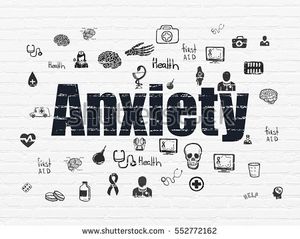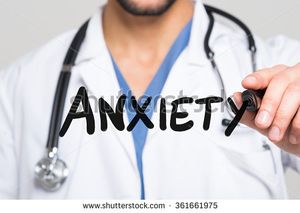GRSJ224/Medicalization of Anxiety
The Medicalization of Anxiety
In General

Anxiety is a very common, and often treatable condition. Although there are many remedies out there that exist for this mental illness, individuals still often struggle greatly when dealing with their anxiety. This is an important disorder to talk about, as it is shown that in a study in 2013, one in nine people worldwide suffers from anxiety, and are known as the most common class of mental disorders [1]. Anxiety causes symptoms such as fear, avoidance, and internal struggle [1]. However, anxiety is not necessarily fear but rather it is the anticipation of certain situations which may make the individual scared or uncomfortable [1]. To officially be diagnosed, the symptoms of anxiety must be constant and effect the individual’s way of living on a daily basis [1].
Geographic & Gender Differences
Gender does play a slight role in deciding who will be affected more by these disorders as according to research, women are twice as likely to have suffered from anxiety [2]. Age is a viable variable as well, as older people are shown to be affected less by anxiety than those that are middle-aged [2]. Across the world rates of anxiety and the prevalence of these disorders vary. In European countries and the USA, there appears to be higher rates of anxiety than the rest of the world [2].
Diagnosis
Under the umbrella term ‘anxiety’ exists many different forms that a patient could be affected by. The way that one might describe their symptoms and feelings of anxiety will help doctors classify which type of disorder they are experiencing. These range from Phobia, to Social Anxiety, Generalized, Panic disorder or Agoraphobia [1], and each of these comes with their separate list of symptoms and effects. Doctors listen closely to patients and often seek out key words which will help them identify which anxiety disorder you are suffering from [1].
Treatment
There exist many options for people suffering from anxiety disorders in terms of treatment through pharmaceutical drugs. The two main and most commonly used drugs used for these disorders are selective serotonin reuptake inhibitors (SSRIs)[3] and benzodiazepines [4]. These two options are relatively modern and promising progress in the treatment of anxiety. The success rates are high, as around 50-60% patients treated with SSRIs show signs of progress [3]. Pharmaceutical options, such as these two drugs, are not the only options for treatment of anxiety. Psychological treatment is another good option for anxiety disorders, and is one that doesn’t require the use of potentially harmful medication [1].
SSRIs
Selective serotonin reuptake inhibitors are known as a gold-standard, first-class medication due to their dependency, efficiency and safety ratings in their role as treatment for anxiety [3]. Placebo studies have been done to check the effectiveness of SSRIs and have proven and supported the use of them to treat persistent and smaller cases of anxiety disorders [5]. Although they show promise, SSRIs do come with the possibility of side effects that may harm the patients which take them. These side effects range from the impairment of memory, concentration, and attention as well as a lack of motivation and can also cause a feeling of numbness and a lack of reactivity for the individuals taking this medication [3]. These feelings have been shown to be present in a large sample of patients that openly voice their concerns about the SSRIs’ affect on their emotional and psychological states [3].

Benzodiazepines
Similar to SSRIs, benzodiazepines are a viable and popular option for the treatment of anxiety. Acting as a relatively new drug on the treatment scene, they were put to the test against other options including anti-depressants and were proven to be a superior option for treating symptoms of anxiety [4]. Short term side effects have been mentioned as a point of concern, but when put against the test against SSRIs, benzodiazepines seemingly have the upper hand in terms of the long-term effects patients experience [4]. Benzodiazepines have also undergone long placebo tests, which have shown that they are an effective and relatively safe option for treatment [4]. Patients have responded, voicing their favorability towards benzodiazepines in both areas of effectiveness and feelings of safety [4].
Psychological Treatment
Cognitive behavioral therapy (CBT) is a psychological treatment which is supported by many studies as being an effective solution for individuals struggling with anxiety disorders [1]. The treatment is concentrated into a certain amount of time and is relatively short term, and is largely a hands-on treatment which attempts to flip the mentality of your thoughts toward certain things [1]. For example, feelings of avoidance and the seeking of comfort are replaced with the mentality of being out-going and coping solutions [1]. Patients are taught strategies that may help when their anxiety flares up, such as breathing techniques and relaxation. Although when CBT is placed against placebo studies it shows limited evidence of improvement, when there is no placebo being compared to CBT it is proven to be effective treatment for anxiety, and perhaps a good alternative to pharmaceutical options [1].

Abuse & Over-Medicalization
Although using prescription drugs has proven to be a viable option for those struggling with anxiety, it is proposed that individuals with high levels of anxiety are at a higher risk of becoming addicted to these same drugs [6]. Patients with anxiety tend to disregard the potential risks of prescription drugs, resulting in abuse and misuse of their medication [6]. In addition, these prescription drugs are being handed out by doctors quite leniently in order to satisfy patients’ needs [7]. The visits with doctors can be brief, are expected to be effective, and there exists pressure on the clinicians to provide a positive and relatively quick fix for a patient’s problems, resulting in a prescription being written for the demanding clients [7].
References
- ↑ 1.00 1.01 1.02 1.03 1.04 1.05 1.06 1.07 1.08 1.09 1.10 Craske, M. G., & Stein, M. B. (2016). Anxiety. The Lancet, 388, 3048-3059. http://dx.doi.org/10.1016/ S0140-6736(16)30381-6
- ↑ 2.0 2.1 2.2 Shah, A. A., & Han, J. Y. (2015). Anxiety. Continuum, 21(3), 772-782. Retrieved from http://ovidsp.tx.ovid.com.ezproxy.library.ubc.ca/sp-3.24.1b/ovidweb.cgi?WebLinkFrameset=1&S=FFLBFPHNPBDDHBIFNCHKOGIBCIPMAA00&returnUrl=ovidweb.cgi%3f%26Full%2bText%3dL%257cS.sh.22.23%257c0%257c00132979-201506000-00018%26S%3dFFLBFPHNPBDDHBIFNCHKOGIBCIPMAA00&directlink=http%3a%2f%2fovidsp.tx.ovid.com%2fovftpdfs%2fFPDDNCIBOGIFPB00%2ffs046%2fovft%2flive%2fgv025%2f00132979%2f00132979-201506000-00018.pdf&filename=Anxiety.&pdf_key=FPDDNCIBOGIFPB00&pdf_index=/fs046/ovft/live/gv025/00132979/00132979-201506000-00018
- ↑ 3.0 3.1 3.2 3.3 3.4 Fornaro, M., Perugi, G., Popovic, D., & Vieta, E. (2014). Cognitive tolerability following successful long term treatment of major depression and anxiety disorders with SSRi antidepressants. Journal of Affective Disorders, 173, 211-215. http://doi.org.ezproxy.library.ubc.ca/10.1016/j.jad.2014.11.008
- ↑ 4.0 4.1 4.2 4.3 4.4 De Witte, L. D., Hoffman, C., Kahn, R. S., Martinez, P., Titulaer, M. J., & Van Mierlo, H. C. (2015). Benzodiazepines in anxiety disorders. JAMA Psychiatry, 72(7). Retrieved from http://jamanetwork.com/pdfaccess.ashx?url=/data/journals/psych/934152/
- ↑ Stein, M. B., & Ravindran, L. N. (2010). The pharmacologic treatment of anxiety disorders: A review of progress. J CLin Psychiatry, 71(7), 839-854. https://doi-org.ezproxy.library.ubc.ca/10.4088/JCP.10r06218blu
- ↑ 6.0 6.1 Burton, S., Delaney, B., Hijjawi, G., & Netemeyer, R. (2015). The legal high: Factors affecting young consumers’ risk perceptions and abuse of prescription drugs. Journal of Public Policy & Marketing, 34(1), 103-118. Retrieved from http://web.b.ebscohost.com.ezproxy.library.ubc.ca/ehost/pdfviewer/pdfviewer?sid=1ccf0cb3-d929-45fc-9b83-5a86e62bf9e5%40sessionmgr104&vid=1&hid=124
- ↑ 7.0 7.1 Miller, M., Rabago, D., & Zgierska, A. (2012). Patient satisfaction, prescription drug abuse, and potential unintended consequences. JAMA, 307(13), 1277-1278. doi:10.1001/jama.2012.419